
4 minute read
Purchasing pavers
PAVER PURCHASING CONSIDERATIONS
WITH MANY SIZES AND ADDITIONAL FEATURES, CHOOSING THE RIGHT ASPHALT PAVING MACHINE REQUIRES EXTENSIVE RESEARCH. ASTEC’S JORGE BOIL EXPLAINS THE KEY CONSIDERATIONS WHEN PURCHASING AN ASPHALT PAVER. O ne of the earliest reports of an asphalt paving machine dates back to the 1930s when Harry Barber, of Barber-Greene Company, invented an asphalt mixing and spreading machine.
Close to 100 years later, asphalt pavers have progressed in leaps and bounds while still containing those original features.
Purchasing an asphalt paver is a large investment, and with so many different features and functions that have developed over time, it is important to know what will best suit the work being produced.
Jorge Boil, Astec Business Line Manager for Infrastructure, says there are a variety of additional paver features to consider to ensure you have the right asphalt paver for the job.
“First, you will need to consider where and how the paver will be used. Be sure to factor in the application, budget, size of job, environment and crew’s experience and skill, as well as preferences,” Mr. Boil says.
“If you are considering doing smaller city jobs, you are probably looking at either a 1.8-metre basic width or 2.5-metre basic width paver which is easy to transport, but if you are looking at a major highway construction job, you will need a paver that has a 3.0-metre basic width which can hydraulically extend to 6.0 metres or more.”
The thickness of the asphalt laid for each job can also require some extra features for the paver. With high-volume asphalt jobs where you are creating a new road, a material transfer vehicle or shuttle buggy may be required to supply more of the asphalt material into the paver.
“Shuttle buggies are a great addition to a paving train that must be considered. These are helpful when you are transporting asphalt across long distances for jobs,” Mr. Boil says.
Asphalt mix comes out of the asphalt plant at the correct temperature, and parts of the mix can cool down when being transported. Mr. Boil says a shuttle buggy remixes the material before it is put through the paver so it can be laid at an even temperature, avoiding temperature segregation and giving you more even compaction.
Mr. Boil says one of the most important things to understand when buying a paver is the maintenance and cleaning requirements.
“This is extremely important because, for example, if you don’t clean a paver at the end of each shift, the asphalt will cool down and stick to the machine and this puts the machine at risk of failures during the next day’s shift. When you start the machine on the next shift, you might break chains on the conveyors because the mix had dried onto them,” he says.
Cleaning can also help to extend the life of a paver because if another issue arises, you can quickly identify the problem and start repairs.
“While it’s important to visually inspect a machine, it’s also imperative to monitor the systems using telematics such as Roadtec’s Guardian System. This data can help you see when maintenance is needed,” Mr. Boil says.
The Roadtec Guardian telematics system is a standard feature in most Roadtec pavers. The system allows users to view aspects of the paving machine in operation from the office.
“You are able to see where the machine is, how much fuel is burning, you can tell whether the paver is on paving mode or if the machine is idle and you can see if there are any issues with the machine and locate those issues,” Mr. Boil says.
He says if a service department is based in a major city and the paver is working regionally, when an issue arises, the team can identify it from afar through the Guardian System. This way, Mr. Boil says, if repairs are needed, the service person can travel to the location prepared with the right parts and tools to fix the issue quickly.
In some instances, the team can correct issues remotely without having to travel to the paver. Roadtec’s Paver Production Reporting is another added feature that allows operators to view the performance of a paver as it relates to real productivity.
“You can see asphalt tonnes laid per day, the day’s total paving distance, the live speed and the total tonnes for the life of the machine, which can help to speed up productivity on site,” Mr. Boil says.
Roadtec also offers dedicated features to its asphalt pavers such as floatation tyres for better traction, flow gates for better control of material head and two dedicated operator stations which hydraulically extend beyond the edge of the paver for better vision during operation.
“Making sure you do the research to find the right paver features suited to your job is important for maximising productivity and minimising downtime,” Mr. Boil says. Roadtec offers a variety of features in its asphalt pavers to maximise productivity.










